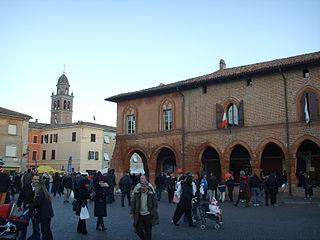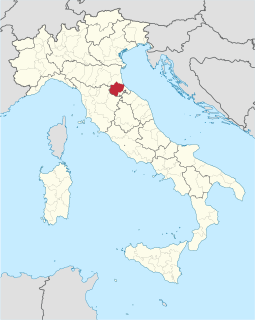Le Strade dei vini e dei sapori (Roads of Wines and Tastes) is the name for the collection of routes in and around Italy, that lead to and through major regional food and wine production areas. [1] [2]
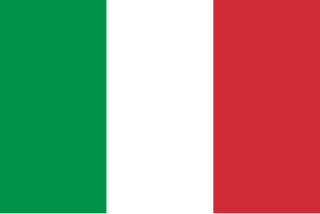
Italy, officially the Italian Republic, is a European country primarily a peninsula delimited by the Italian Alps and surrounded by several islands. Located in the middle of the Mediterranean sea and traversed along its length by the Apennines, Italy has a largely temperate seasonal climate. The country covers an area of 301,340 km2 (116,350 sq mi) and shares open land borders with France, Slovenia, Austria, Switzerland and the enclaved microstates of Vatican City and San Marino. Italy has a territorial exclave in Switzerland (Campione) and a maritime exclave in the Tunisian Sea (Lampedusa). With around 60 million inhabitants, Italy is the fourth-most populous member state of the European Union.
Contents
These routes, all in Emilia Romagna, are:
- in the Province of Piacenza:
- Strada dei vini e dei sapori dei Colli Piacentini
- in the Province of Parma:
- Strada del Culatello di Zibello
- Strada del Prosciutto e dei vini dei Colli di Parma
- Strada del Fungo Porcino di Borgotaro
Zibello is a town in the Province of Parma in the Italian region Emilia-Romagna, located about 110 kilometres (68 mi) northwest of Bologna and about 30 kilometres (19 mi) northwest of Parma. It was an independent comune until 1 January 2016, when it merged with Polesine Parmense to form the new comune of Polesine Zibello.

Prosciutto is an Italian dry-cured ham that is usually thinly sliced and served uncooked; this style is called prosciutto crudo in Italian and is distinguished from cooked ham, prosciutto cotto.
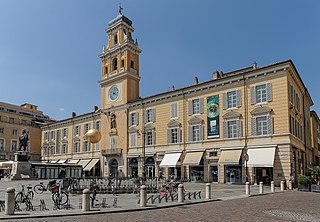
Parma is a city in the northern Italian region of Emilia-Romagna famous for its architecture, music, art, prosciutto (ham), cheese and surrounding countryside. It is home to the University of Parma, one of the oldest universities in the world. Parma is divided into two parts by the stream of the same name. The district on the far side of the river is Oltretorrente. Parma's Etruscan name was adapted by Romans to describe the round shield called Parma.
- in the Province of Reggio Emilia:
- Strada dei vini e dei sapori delle Corti Reggiane
- Strada dei vini e dei sapori Colline di Scandiano e Canossa

Reggio nell'Emilia, usually referred to as Reggio Emilia or colloquially Reggio by its inhabitants, is a city in northern Italy, in the Emilia-Romagna region. It has about 171,944 inhabitants and is the main comune (municipality) of the Province of Reggio Emilia.

Scandiano is a town and comune in Emilia-Romagna, in the northeast part of the country of Italy, near the city of Reggio nell'Emilia and the Secchia river. It had a population of 25,663 as of 31 December 2016.
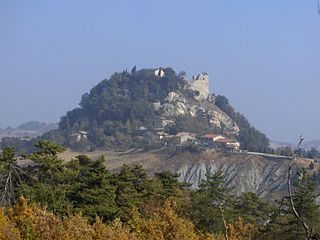
Canossa is a comune and castle town in the Province of Reggio Emilia, Emilia-Romagna, northern Italy. It is the site where Holy Roman Emperor Henry IV did penance in 1077, standing three days bare-headed in the snow, in order to reverse his excommunication by Pope Gregory VII. The Walk to Canossa is sometimes used as a symbol of the changing relationship between the medieval Church and State.
- in the Province of Modena:
- Strada dei vini e dei sapori della Pianura Modenese
- Strada dei vini e dei sapori Città Castelli Ciliegi

Modena is a city and comune (municipality) on the south side of the Po Valley, in the Province of Modena in the Emilia-Romagna region of northern Italy.
- in the Metropolitan City of Bologna:
- Strada dei vini e dei sapori dei Colli d'Imola
- in the Province of Ferrara:
- Strada dei vini e dei sapori Provincia di Ferrara
- in the Province of Ravenna:
- Strada del Sangiovese dei sapori delle Colline di Faenza

Sangiovese is a red Italian wine grape variety that derives its name from the Latin sanguis Jovis, "the blood of Jupiter". Though it is the grape of most of central Italy from Romagna down to Lazio, Campania and Sicily, outside Italy it is most famous as the only component of Brunello di Montalcino and Rosso di Montalcino and the main component of the blends Chianti, Carmignano, Vino Nobile di Montepulciano and Morellino di Scansano, although it can also be used to make varietal wines such as Sangiovese di Romagna and the modern "Super Tuscan" wines like Tignanello.

Faenza is an Italian city and comune, in the province of Ravenna, Emilia-Romagna, situated 50 kilometres southeast of Bologna.
- in the Province of Forlì-Cesena:
- in the Province of Rimini:
- Strada dei vini e dei sapori dei Colli di Rimini
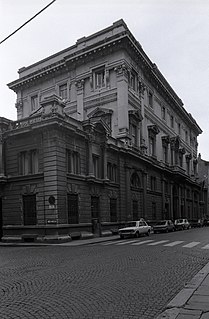
The province of Piacenza is a province in the Emilia-Romagna region of Italy. Its provincial capital is the city Piacenza. As of 2016, it has a total population of 286,572 inhabitants over an area of 2,585.86 square kilometres (998.41 sq mi), giving it a population density of 111.38 inhabitants per square kilometre. The city Piacenza has a population of 102,269, as of 2015. The provincial president is Patrizia Barbieri and it contains 48 comuni. The province dates back to its founding by the Romans in 218 BCE.

Piacenza is a city and comune in the Emilia-Romagna region of northern Italy, the capital of the eponymous province. The etymology is long-standing, tracing an origin from the Latin verb placēre, "to please." In French, and occasionally in English, it is called Plaisance. The name means a "pleasant abode", or as James Boswell reported some of the etymologists of his time to have translated it, "comely". This was a name "of good omen."

The Province of Parma is a province in the Emilia-Romagna region of Italy. Its largest town and capital is the city of Parma.
